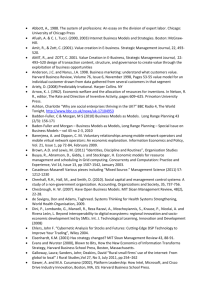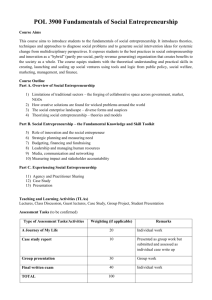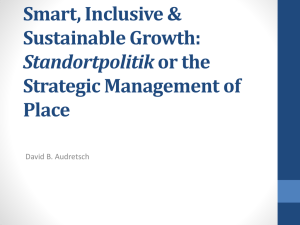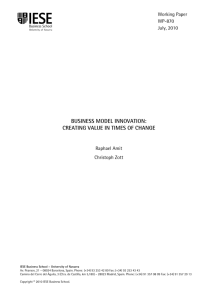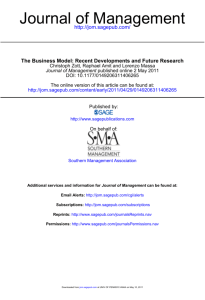The Business Model
advertisement
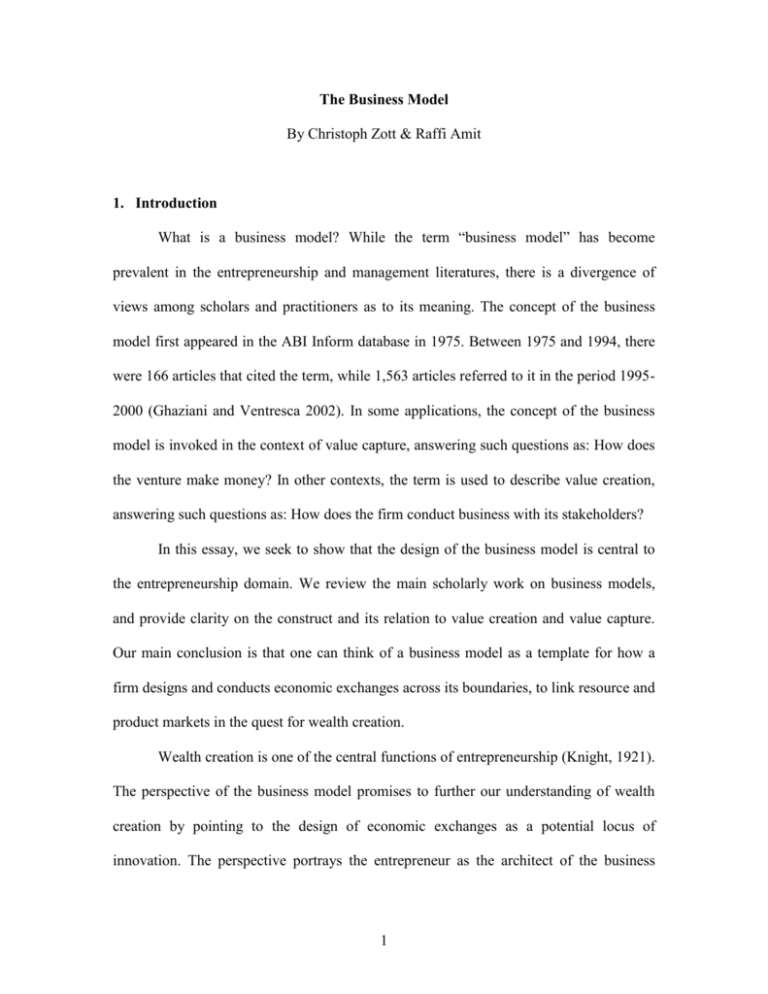
The Business Model By Christoph Zott & Raffi Amit 1. Introduction What is a business model? While the term “business model” has become prevalent in the entrepreneurship and management literatures, there is a divergence of views among scholars and practitioners as to its meaning. The concept of the business model first appeared in the ABI Inform database in 1975. Between 1975 and 1994, there were 166 articles that cited the term, while 1,563 articles referred to it in the period 19952000 (Ghaziani and Ventresca 2002). In some applications, the concept of the business model is invoked in the context of value capture, answering such questions as: How does the venture make money? In other contexts, the term is used to describe value creation, answering such questions as: How does the firm conduct business with its stakeholders? In this essay, we seek to show that the design of the business model is central to the entrepreneurship domain. We review the main scholarly work on business models, and provide clarity on the construct and its relation to value creation and value capture. Our main conclusion is that one can think of a business model as a template for how a firm designs and conducts economic exchanges across its boundaries, to link resource and product markets in the quest for wealth creation. Wealth creation is one of the central functions of entrepreneurship (Knight, 1921). The perspective of the business model promises to further our understanding of wealth creation by pointing to the design of economic exchanges as a potential locus of innovation. The perspective portrays the entrepreneur as the architect of the business 1 system, and as a creative designer (and, potentially, innovator) of economic exchanges, which complements received notions of entrepreneurs as product and process innovators. In designing their business models, entrepreneurs throughout the world have been able to leverage recent advances in information and communication technologies. This has contributed to a shift in the locus of competitive advantage from the new venture and its internal stakeholders (e.g., management, shareholders, employees) to its ecosystem, which includes external stakeholders such as partners, vendors, and customers. Indeed, advances in digital technologies have opened up new opportunities for the design of boundary-spanning exchange relationships among firms, partners and customers. As a result, business models have become a possible source of value creation. 2. Literature review At this early stage in the development of the business model perspective, a dominant view has not yet emerged, as different conceptualizations of the business model emphasize various aspects of wealth creation. Broadly speaking, some concepts center on value creation, while others focus more on value appropriation through, for example, revenue generation. Finally, some authors propose a more encompassing definition of the term, embracing aspects of both value creation and appropriation. Based on the observation that no single entrepreneurship or strategic management theory can fully explain the value creation potential of highly interconnected firms, Amit and Zott (2001) conceptualize the business model as a unit of analysis that captures the value creation potential arising from the design of transactions between a focal firm and external stakeholders such as partners, vendors, and customers. The business model spans firm and industry boundaries. This perspective integrates the theoretical views of the 2 value chain framework (Porter, 1985), Schumpeter’s theory of creative destruction (Schumpeter, 1942), the resource-based view of the firm (Amit and Shoemaker, 1993), strategic network theory (Gulati, 1998), and transaction cost economics (Williamson, 1975). The sources of value creation suggested by these theories refer to factors that enhance the total value created in transactions (Brandenburger and Stuart, 1996), and which give rise to four distinct themes (novelty, efficiency, complementarities, and lockin) that can be used to describe and measure business model design (Zott and Amit, 2003). Building on the value creation perspective, Magretta (2002) conceptualizes business models as “stories that explain how enterprises work” (2002: 87), and that center on a value-creating insight. The main questions a business model answers are: Who is the customer? What does the customer value? What is the underlying logic that explains how a firm can deliver value to customers at an appropriate cost? According to this view, the business model is distinct from strategy, because it describes how a firm does business, while strategy describes how the firm deals with competition (see, also, Zott and Amit, 2003). Other researchers suggest that the business model refers more to questions about value appropriation. Eisenmann, for example, views the business model as “a hypothesis about how a company will make money over the long term: what the company will sell, and to whom; how the company will collect revenue; what technologies it will employ; when it will rely on partners; and, following from the last two points, how its costs will ‘scale’ with growth.” (2002: xii).1 Applying this conceptualization to e-businesses, Amit and Zott (2001) denote some of these characteristics as the revenue model, which “refers to the specific modes in which a business model enables revenue generation” (2001: 515). 1 3 Eisenmann (2002) presents and analyzes eight generic types of business models: access providers, portals, content providers, retailers, brokers, market makers, networked utility providers, and application service providers. Combining both value creation and value appropriation perspectives, Afuah and Tucci (2000), as well as Chesbrough and Rosenbloom (2002), propose more encompassing views of the business model. Afuah and Tucci suggest that, “A business model can be conceptualized as a system that is made up of components, linkages between the components, and dynamics.” (2000: 4) The components of the business model are customer value, customer segments, scope of products and services, pricing, revenue sources, connected activities, implementation, capabilities, and sustainability. In a similar vein, building on the technology management literature, Chesbrough and Rosenbloom (2002: 533-534) present the business model as a construct that mediates between technological inputs and economic outputs. The functions of a business model are to (1) articulate the value proposition; (2) identify a market segment, as well as the revenue generation mechanism for the firm; (3) define the structure of the value chain; (4) estimate cost structure and profit potential; (5) describe the position of the firm within the network linking suppliers, customers, complementors, and competitors; and (6) formulate a competitive strategy. The various approaches offered in the academic literature are a clear indication that research on business models could be advanced by a convergence of the field to a common understanding of the construct. Promising ideas that could serve as catalysts for such a convergence might be the notions of inter-organizational architecture (Mendelson, 2000) and design (Hargadorn and Yellowlees, 2001; Romme, 2003; Zott and Amit, 4 2003). Mendelson maintains that the performance of the firm depends on the “architecture of the entire business network” (2000: 519). Examining how entrepreneurs market innovations, Hargadorn and Yellowlees point to the central role of the design of the business system, which is centered on “a particular set of understandings and interactions” (2001: 494) between different stakeholders, such as the firm and its customers. Romme (2003) notes that the purpose of design is to produce systems that do not yet exist, and Zott and Amit (2003) show how the design of the business model is central to wealth creation through entrepreneurship. Next, we elaborate in more detail on one theoretically rigorous conceptualization of the business model which is consistent with these ideas, and which has proven useful for empirical analysis. 3. Our conceptualization Consistent with the theoretical development in Amit and Zott (2001), the business model can be defined as depicting the content, structure, and governance of transactions designed to create value through the exploitation of business opportunities. Transaction content refers to the goods or information that are being exchanged, and to the resources and capabilities that are required to enable the exchange. Transaction structure refers to the parties that participate in the exchange, and to the ways in which these parties are linked (including the sequencing of exchanges, and the adopted exchange mechanisms). Transaction governance refers to the ways in which flows of information, resources, and goods are controlled by the relevant parties (including the legal form of organization, and the incentives for exchange participants). This conceptualization of a business model encompasses transaction efficiency (emphasized by TCE; see Williamson, 1975), novelty in transaction content, structure 5 and governance (Schumpeterian innovation; see Schumpeter, 1934), complementarities among resources and capabilities (advocated by RBV; see Amit and Shoemaker, 1993), and network effects (inherent in strategic networks; see Gulati, 1998). It also integrates important entrepreneurship and strategy theories, and thus potentially heightens our understanding of the complex processes and mechanics that drive wealth creation (Hitt, Ireland, Camp, and Sexton, 2001). The proposed construct is parsimonious, distinct from competitive business-level strategy, and it can be oprerationalized and measured. Zott and Amit (2003), for example, develop and test hypotheses about the impact of business model design on wealth creation by entrepreneurial firms. Their content analysis of firms’ IPO prospectuses shows that novelty-centered business model design matters most to the equity value created by these firms. It also points to a potential differential impact of business model design themes under varying resource munificence regimes, and to potential diseconomies of scope in design. Thus, the business model holds promise for advancing entrepreneurship research, both theoretically and empirically. 4. Research opportunities Research on business models, then, could benefit from a convergence of the field to a common understanding of the construct, through both theory development and empirical research. Consensus on the theoretical foundation and fundamental properties could lead to the emergence of broadly accepted typologies of business models, which are currently lacking. Further research on the relationship between the business and revenue models of firms is needed to extend both theory and practice. Such research will help deepen our understanding of the linkages between value creation and value 6 appropriation. Empirical research on the measurement of business model design, structured to capture all lines of a firm’s business that have revenue potential, holds great promise to enhance our understanding of business models. Examining the dynamics of business model evolution, how they emerge, and how they are shaped and adapted over time, as well as how business models co-evolve with strategy and organization design, reflects an important research program that will substantially solidify the business model as a unit of analysis that is pivotal to our understanding of wealth creation. In summary, we are at the very beginning of a long journey to identifying and evaluating a new level of analysis for entrepreneurial firms. Theoretical, empirical, and field research on the foundations and evolutions of business models promises to broaden our understanding of wealth creation through entrepreneurship. References Afuah, A., Tucci, C. L. 2000. Internet Business Models and Strategies: Text and Cases. Irwin/McGraw-Hill: New York, NY. Amit, R., Schoemaker, P. 1993. Strategic assets and organizational rent. Strategic Management Journal, 14: 33-46. Amit, R., Zott, C. 2001. Value creation in e-business. Strategic Management Journal, 22: 493-520. Brandenburger, A. M., Stuart, H. 1996. Value-based business strategy. Journal of Economics & Management Strategy, 5: 5-25. 7 Chesbrough, H., Rosenbloom, R. 2002. The role of the business model in capturing value from innovation: evidence from Xerox Corporation’s technology spinoff companies. Industrial and Corporate Change, 11: 529-555. Eisenmann, T. R. 2002. Internet Business Models. McGraw-Hill Irwin: New York: NY. Ghaziani, A., Ventresca, M. J. 2002. Discursive fields, boundary objects, and the categorical structuring of discourse: Evidence from frame analysis of business model public talk, 1975-2000. Working Paper Northwestern University, April 2002. Gulati, R. 1998. Alliances and networks. Strategic Management Journal, 19: 293-317. Hargadorn, A. B., Yellowlees, D. 2001. When innovations meet institutions: Edison and the design of the electric light, Administrative Science Quarterly, 46: 476-501. Hitt, M. A., Ireland, R. D., Camp, S. M., Sexton, D. L. 2001. Strategic entrepreneurship: Entrepreneurial strategies for wealth creation. Strategic Management Journal, 22: 479-491. Knight, F. H. 1921. Risk, uncertainty and profit. Cambridge, MA, Boston, and New York The Riverside Press. Magretta, J. 2002. Why business models matter. Harvard Business Review May 2002: 86-92. Mendelson, H. 2000. Organizational architecture and success in the information technology industry. Management Science, 46: 513-529. Porter, M. E. 1985. Competitive Advantage: Creating and Sustaining Superior Performance, Free Press, New York, NY. Romme, A. G. L. 2003. Making a difference: organization as design. Organization Science, 14: 558-573. 8 Schumpeter, J. A. 1934 (Reprint 1996). The theory of economic development: An inquiry into profits, capital, credit, interest, and the business cycle. Cambridge, MA: Harvard University Press. Schumpeter, J. A. (1942). Capitalism, Socialism, and Democracy, Harper, New York, NY. Venkatraman, S. 1997. The distinctive domain of entrepreneurship research. Advances in Entrepreneurship, Firm Emergence and Growth, 3: 119-138. Williamson, O. E. 1975. Markets and hierarchies --Analysis and antitrust implications. New York: The Free Press. Zott, C., Amit, R. 2003. Business model design and the performance of entrepreneurial firms. INSEAD Working Paper 2003/94/ENT/SM/ACGRD 4. 9
